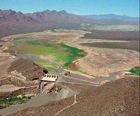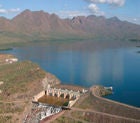Phoenix launches a Citywide food drive to assist residents experiencing food insecurity during the holidays.
Drought and Climate Change
 Horseshoe Lake on the Verde River - During Dry Conditions
Horseshoe Lake on the Verde River - During Dry Conditions
Security in Diversity
Phoenix's diverse water supply portfolio, greater conservation, and efficient management of supplies combine to minimize the impact of drought on customers. However, with a growing population and the possibility of impacts from climate change, facing the droughts of the future could be a more difficult challenge. The 2021 Water Resource Plan looks ahead and addresses the risks and potential challenges the city may face in the coming decades.
Mother Nature can be unpredictable, but there are ways to minimize the impact of her changeability. Having a diversity of sources for your water is an important part of this; although it is not unusual for one supply category to have a shortfall, it would be rare that Salt River Project and Central Arizona Project supplies are dry at the same time.
 Horseshoe Lake on the Verde River - During Wet Conditions
Horseshoe Lake on the Verde River - During Wet Conditions
Understand the Future
Records show that over the past 500 years, there have been three extended periods of drought conditions, when both the Colorado River and Salt River watersheds received below-average precipitation for periods of 20 years or more. There were extended dry periods in the late 16th century, late 19th century, and in the post-war period. In contrast, the early 20th century was unusually wet.
Global climate change has the potential to impact the frequency and severity of water shortages. Long-term temperature increases in source watersheds could reduce precipitation. Of greatest concern is the possibility of reduced snow pack, which would mean reductions in the amount of water that flows into the storage reservoirs in the spring and summer months. More information on how the City plans to meet your water needs in the face of these challenges can be found in the 2021 Water Resource Plan.